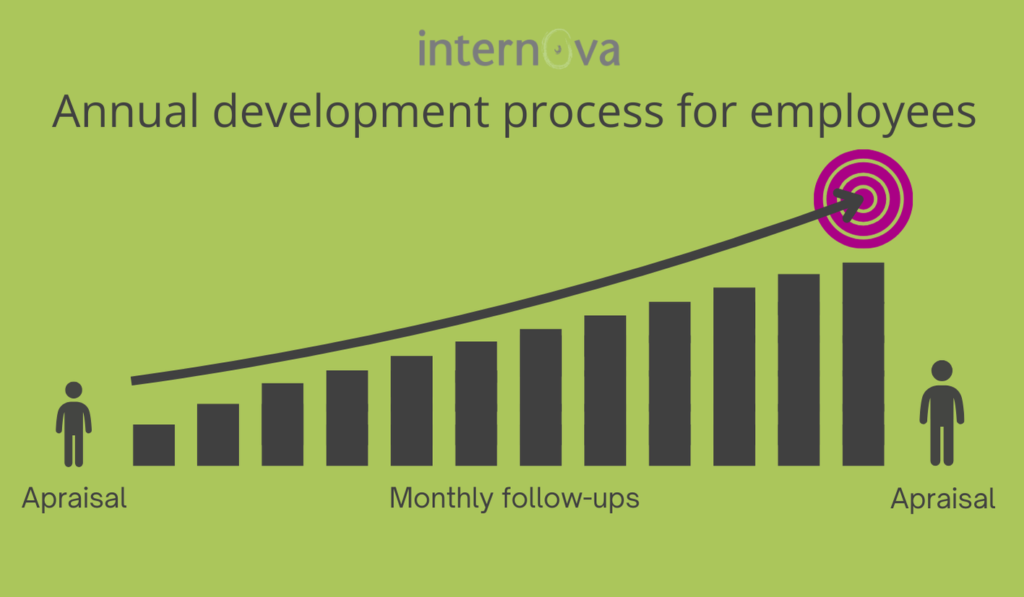What it takes for effective annual performance appraisals
Many workplaces offer online or on-site training. However, there is often a lack of a clear annual development process for each employee. To succeed, a systematic development process is needed, with annual performance appraisals as a central tool. The problem with the annual performance appraisals is that they often become an isolated island.
Sporadic courses are not enough; each manager must act as a process manager for their closest reporting employees. It provides a continuous development process that makes everyone in the company grow every week. The result is a company that succeeds in its changes, continuously develops, strengthens its competitiveness and becomes an attractive workplace.
There is a large untapped resource in many companies: every manager with personnel responsibility adopts a systematic development process for their closest employees. Effective leadership drives the process of getting employees to develop by, for example, working more structured, planned, reducing stress, solving recurring problems themselves, thinking in new ways and increasing their performance.
To succeed with effective leadership, employee development must start with managers learning to run a systematic development process for employees. In this blog, you will read about why annual performance appraisals do not work, how they provide maximum benefit, and why your immediate manager is the most suitable process leader for systematic employee development.
Why annual performance appraisals don't work
When regular follow-ups of annual employee appraisals are lacking, it will not become an employee’s development.
It seems so easy to set goals for a year ahead at the annual performance appraisal, for example. But what happens next? If the annual goals are not followed up in a structured way, there is a great risk that the same problem will be discussed at the next annual employee meeting. It is handled as another in the number of tasks to be ticked off, for both managers and employees.
To work more efficiently, everyone needs to prioritise their most important tasks every day. In addition, every employee needs to regularly develop and learn to increase their performance, so that the company succeeds in change, becomes more competitive, and creates better results. To get every employee to constantly increase their performance, development must be seen as a task and that they are supported in their development process.
How annual performance appraisals are effective
All development is a process. We are all creatures of habit, and our brain prefers to do the same way we have always done. That’s why it’s tough with changes. Every person who needs to develop needs encouragement, time, training and feedback on their development process. That is why follow-ups of the annual performance appraisal are so important. One call a year is not enough.
The annual performance appraisal will be part of Systematic Development Process of Employees and will be supplemented with regular individual employee follow-ups. Investing in the employees’ development process makes a big difference in the long run. With the right systematic process for employee development, each employee can increase their performance by at least 20% every year.

Why the immediate manager is most suitable for driving the systematic development process of employees
Since the immediate manager is in regular contact with their employees, they are also best suited to be responsible for the employees’ development process. To create the right conditions and documented results, a company-wide policy for the Systematic Development Process of Employees is needed. Managers need to understand why, the benefits of it, and learn how to use it.
Managers regularly meet with their direct reporting employees online and offline in various forums. For example, through daily communication about the work, at various meetings and annual development discussions. Many companies have also introduced regular individual employee meetings, from weekly to once a month.
With all the contact surfaces managers have with their closest employees, they communicate often, and the better the contact, the greater trust and confidence in each other. Due to their close working relationship, it should be the immediate manager’s responsibility to systematically drive the development process of employees to achieve their development and work goals.
If each manager introduces systematically regular individual employee meetings with a focus on development, learning and practical training between meetings, there will be huge potential for development. Many companies that today have individual regular employee meetings focus mostly on employees’ daily work, and little or no part is about systematically driving employees’ development process, through learning and training, to reach their development needs.
By implementing the Systematic Development Process of Employees, all employees’ development goals will be achieved every year. Imagine if all managers could get every employee to improve their work, working methods, and increase their competence, skills and performance by 20 percent every year. What a blow and fantastic results it would have for employees, managers and the company.
“The greatest leader is not necessarily the one who does the greatest things. He is the one who makes the people do the greatest things.”
Ronald Reagan
Summary
Annual performance appraisals are an important part of systematic employee development, but they must be supplemented with regular follow-ups and individual meetings that focus on the employee’s change process to be effective. Managers play a central role in this process by acting as process leaders and creating a continual development environment. By implementing a systematic development process for workers, companies can improve their performance and create a more attractive workplace.
Would you like to learn more about employee development?
Klicka på länken för att komma till bloggen: “Embrace leadership that develops employees to help them grow“


